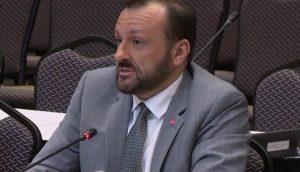In the last 10 years, the role of content in advertising has gone from a nice-to-have to a must-have. From Westjet’s ongoing Christmas Miracle program to Interac’s recent branded podcast, brands are understanding the importance of giving consumers something they can – to put it plainly – consume. As the amount of content increases, the strategies behind the content becomes more and more sophisticated.
But as the content production ramps up, so do the complications: how much is too much to spend on a 30-second Facebook video spot? Where does an ad end and content begin? What are the new KPIs by which brands measure the success of the content? And, perhaps most importantly, which agency partner takes the lead on content?
Media in Canada and strategy gathered a group of content marketers, agency leaders and studio heads to discuss over dinner and drinks the evolving role of content in the media ecosystem. Throughout the night, the participants broached every subject, from creative control to taboo talks of cost.
Present at the table were Darcy MacNeil, head of Content+ at Mindshare; Lindsay Wilson, head of MediaCom Beyond Advertising; Andrew Saunders, CRO at The Globe and Mail; Robin Neufeld, director of content marketing at CBC/Radio-Canada; Nadia Beale, SVP and consumer practice leader at MSL Group; Susan Irving, senior director of marketing at Pepsico; Sean Stanleigh, managing editor, Globe Content Studio at The Globe and Mail; Mike Sutton, president of Zulu Alpha Kilo; and Tracy Jones, managing director of Alternator.
Quotes have been edited for clarity and length.
MiC: Now that content programs are more established and more common, what are brands looking to achieve? How have expectations changed?
The Globe’s Sean Stanleigh: There are a lot more campaigns that are full-funnel. We used to see just brand awareness, just consideration, maybe a few low-funnel. Now, we require much more customized solutions.
And, they don’t just want the Globe and Mail audience, they want the audience outside that. Targeting has become a lot more important.
It’s also in the variety of the content; podcast, video, high-end design and execution. What are some of the new frontiers? AR/VR, how do we get involved? Should we get involved? How do we incorporate data into that, bring it right down to the storytelling, and figure out the way to best disseminate that storytelling?
Mediacom’s Lindsay Wilson: I’m seeing more clients understand that content needs to be part of a larger campaign and full strategy, versus just “I want some content, but I’m also running this campaign over here that has nothing to do with it.” And we’re starting to help them understand the role of that content, what kind of KPIs they can expect, and how it helps the system work together.
Alternator’s Tracy Jones: I think we’re at a tipping point. The first three years running Alternator was [brands saying] “Let’s try content.” Now it’s not even about how content fits into the strategy. Content is the strategy. It’s becoming less about a tactical execution and more about how we weave that into everything we do. “You need a Facebook strategy” was what people said 10 years ago. And we’d say, “No, you need a marketing strategy that you fit Facebook in.” Content is the same thing now.
Pepsico’s Susan Irving: There’s a role for everything, but it’s got to be part of the master strategy. Influencers are content, and it’s an important part of content. Every brand wants a purposeful brand, but how do you build it? You’re not going to by just having a 30-second television commercial. It’s about building a purposeful brand by connecting with consumers the way they’re consuming. As Instagram starts to get very big, and bigger than Facebook in some instances, you have to figure out the influencer strategy.
Zulu’s Mike Sutton: In the grand scheme of things, maybe a difference between content and the other stuff, is push versus pull. There’s going to be radio, there’s going to be online, there’s going to be lots of things. The content part of that is going to be connected to the strategy, but it’s probably a different piece of creative than what’s running online or on radio. Everything’s content, I agree, but the content, the way that we’re defining it, is a story that we’re trying to pull an audience into as opposed to just push it out.
Mindshare’s MacNeil: And where does the brand fit naturally and authentically into that story? For us, one of the things we’re noticing is that while everything started with the content first – what does it need to look like, sound like – what we’re trying to do is push it to be more consumer-first and demographic-first. What’s going to ultimately drive the consumer to take action? Let’s insert our brand authentically into those narratives.
Jones: But then the battle becomes, who’s in charge? Is it the creative agency? Is it the media company? Is it the PR agencies? Having worked in an organization where I’ve been in a room with the PR agency, the ad agency, the promotional agency, the shopper marketing agency, all duking it out…
Irving: Don’t most company brief that way? When I’m briefing big programs, I have all my agencies in one room together…
MSL Group’s Beale: Which makes sense.
Irving: You come up with a big idea, and then we decide how we’re going to play.
Jones: And then you [the marketer] are playing referee. I think there’s a bit of a crisis happening in the agency world in terms of who’s in charge of what. I saw it when I was on the creative side. The digital people at one agency would be fighting with a sister agency in the same network…
Irving: And the channels are blurring. The digital agencies can doing influencers, or the PR agencies can do content.
Beale: And we’re a PR agency with a content shop, so I see where you’re coming from. It’s quite blurry.
Irving I think before you go into a briefing, as long as you set the parameters ahead of time and make sure everyone’s contributing, everyone can get a piece of that pie as long as your AORs are set up accordingly at the get-go. But maybe that’s the problem that AORs aren’t set up properly.
Wilson: I think some of the people sitting here, even though it’s media agency, media agency, media agency, none of us have media agency backgrounds. We have production backgrounds, creative backgrounds. Media agencies are hiring creative folk. In a media agency, you have a plethora of data and measurement. That’s the point of difference.
MiC: So with so many different models, I wanted to touch on the advantages of working with different agency partners. What can different agencies bring to the table?
Sutton: I don’t know if there’s a right answer to that. Where’s the talent? Where’s the capability? I think there are PR agencies out there that are doing content in terms of the conceptual work to conceive an idea, the content strategy work to see where it’s going to live, and then the measurement, to your [Wilson’s] point.
 Irving: I think it all depends on what’s your budget, and is this a big push, or a test?
Irving: I think it all depends on what’s your budget, and is this a big push, or a test?
Sutton: So do you go to a different agency if the budget is smaller?
Irving: Potentially. If it’s going to be something tried, true and tested, 80% of my budget, my bigger-lead agencies are going to be the ones that are strategically involved. If it’s something I’m not going to test and take a chance on, I need to go with who has the ability to do it in a quicker, nimble way.
Jones: I think it varies client by client. I remember when we first got going, there was an RFP that went out for a big Canadian brand. The RFP was “low cost video production suppliers.” It was costing them so much to do 10-second promotional Facebook ads for retail. Their big brand agency, which was one of the big holding company initial agencies, was charging $280,000 to do 50, 10-second Facebook things. They were like, “We need this done every month. We can’t be spending this kind of money, and we don’t need the executive creative directors on this.”
Wilson: These are the exact kind of RFPs my team is getting now.
Jones: That was three years ago. I thought that was a signal that was being sent out to the industry that it can’t all be South Africa TV productions.
Irving: There’s a place for everyone. I just think with content, there’s briefs where you don’t need a strategy team, you don’t need all this headcount. You potentially need directors in-house. That’s why Pepsi started Creators League in New York. Everything’s in-house but you don’t have an account team or a strategy team. You’re working face-to-face with the production team.
Beale: I think you have to look at the content very differently from your brand sell. You’re not pumping out as much brand sell as content.
 Jones: A lot of what we really enjoy getting involved in is standing next to the content, not in it. We’re producing shows related to the brand, and sometimes we’ll do custom episodes or custom content, what people want to see is stuff that they’re interested in. Mark Maron, on his podcast, is totally willing to promote the brands and the people who are paying for the podcast.
Jones: A lot of what we really enjoy getting involved in is standing next to the content, not in it. We’re producing shows related to the brand, and sometimes we’ll do custom episodes or custom content, what people want to see is stuff that they’re interested in. Mark Maron, on his podcast, is totally willing to promote the brands and the people who are paying for the podcast.
Stanleigh: There’s an authenticity to it.
Jones: It’s almost back to the old way of thanking your sponsors. There’s now a need for us to become show producers in a way, and what that demands is that the content is actually good, not just ticking off a box and asking, “Did we content today?”
MacNeil: It’s that 80/20 rule of working versus non-working dollars.
Jones: When I look at the work that Doritos has done with the Super Bowl, you were at the forefront of giving the brand away and saying “Take this and celebrate it.” Years ago, it was, “No, no, don’t touch my logo.”
Irving: If you go on the Doritos U.S. Instagram account, it’s all done by consumers. It’s the whole model of Doritos of giving consumers the stage.
Stanleigh: A Globe and Mail Doritos content campaign is a challenge I would accept, but it would be very different than how we would approach something like an automotive business or a bank. We like to say to brands, “Challenge us, give us the problems you’re trying to solve.” A commercial is, “Hey, look at this cool stuff.”
CBC’s Robin Neufeld: There’s different purposes content can serve. It’s either entertaining, or an escape, or information. I think the crux of it, is the consumer psyche, in the moment of what your experience might be. But it comes down to a really good consumer marketing strategy.
Irving: And, do you have a right to play there?
Photos by Kevin Cordick

























